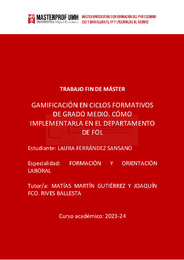Please use this identifier to cite or link to this item:
https://hdl.handle.net/11000/32906Full metadata record
| DC Field | Value | Language |
|---|---|---|
| dc.contributor.advisor | Martín Gutiérrez, Matías | - |
| dc.contributor.advisor | Rives Ballesta, Joaquín Francisco | - |
| dc.contributor.author | Ferrández Sansano, Laura | - |
| dc.date.accessioned | 2024-09-02T12:02:37Z | - |
| dc.date.available | 2024-09-02T12:02:37Z | - |
| dc.date.created | 2024-06 | - |
| dc.identifier.uri | https://hdl.handle.net/11000/32906 | - |
| dc.description | Especialidad: Formación y orientación laboral | es_ES |
| dc.description.abstract | Uno de los objetivos actuales para el sistema de formación profesional es alcanzar una formación integral tanto en contenidos como en habilidades, lo que puede ser complicado debido a la escasa motivación del alumnado de CFGM en módulos teóricos como FOL. La gamificación se erige como una estrategia innovadora que, además de mejorar la motivación del alumnado fomenta el desarrollo de competencias clave en la futura carrera profesional del alumnado. Mediante el análisis bibliográfico de gran parte de la literatura existente sobre el tema se va a analizar el impacto que esta metodología tiene sobre el proceso de enseñanza – aprendizaje en CFGM. Este enfoque fomenta una enseñanza participativa donde el alumnado adquiere los conocimientos teóricos y además colabora, resuelve problemas y toma decisiones, mejorando así la comprensión de los contenidos y habilidades abordados mientras se trabaja el desarrollo de competencias transversales, como habilidades blandas y competencias digitales. A pesar de que su aplicación requiere un esfuerzo significativo por parte del profesorado, los beneficios de la gamificación son evidentes y a día de hoy existe un elevado número de estrategias y recursos para poner esta metodología en práctica. Por ello, se recomienda su integración como una estrategia pedagógica valiosa, efectiva y beneficiosa | es_ES |
| dc.description.abstract | One of the current objectives for the vocational training system is to achieve comprehensive training in both content and skills, which can be challenging due to the low motivation of students in Vocational Training Intermediate Grade (CFGM) theoretical modules such as FOL. Gamification emerges as an innovative strategy that, in addition to enhancing student motivation, promotes the development of key competencies in students' future careers. Through a bibliographic analysis of a large part of the existing literature on the subject, the impact of this methodology on the teaching-learning process in CFGM is going to be studied. This approach promotes participatory teaching where students acquire theoretical knowledge and also collaborate, solve problems, and make decisions, thus improving the understanding of the content and skills addressed while working on the development of transversal competencies, such as soft skills and digital competencies. Although its implementation requires a significant effort from teachers, the benefits of gamification are evident, and there is currently a large number of strategies and resources available to implement this methodology. Therefore, its integration is recommended as a valuable, effective, and beneficial pedagogical strategy | es_ES |
| dc.format | application/pdf | es_ES |
| dc.format.extent | 37 | es_ES |
| dc.language.iso | spa | es_ES |
| dc.publisher | Universidad Miguel Hernández | es_ES |
| dc.rights | info:eu-repo/semantics/openAccess | es_ES |
| dc.rights | Attribution-NonCommercial-NoDerivatives 4.0 Internacional | * |
| dc.rights.uri | http://creativecommons.org/licenses/by-nc-nd/4.0/ | * |
| dc.subject | Aprendizaje basado en juegos | es_ES |
| dc.subject | Formación profesional | es_ES |
| dc.subject | Motivación | es_ES |
| dc.subject | Habilidades blandas | es_ES |
| dc.subject | Metodologías innovadoras | es_ES |
| dc.subject.other | CDU::3 - Ciencias sociales::37 - Educación. Enseñanza. Formación. Tiempo libre | es_ES |
| dc.title | Gamificación en ciclos formativos de grado medio. Cómo implementarla en el departamento de FOL | es_ES |
| dc.type | info:eu-repo/semantics/masterThesis | es_ES |

View/Open:
TFM Ferrández Sansano, Laura.pdf
2,29 MB
Adobe PDF
Share:
.png)
